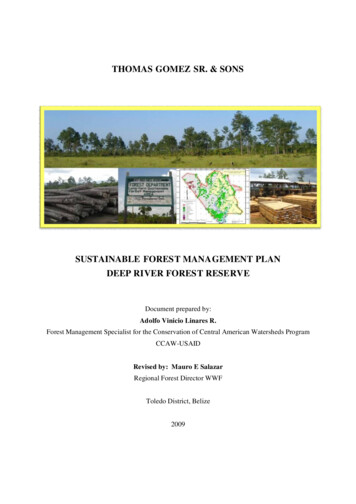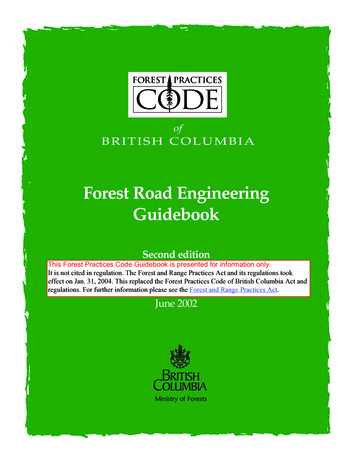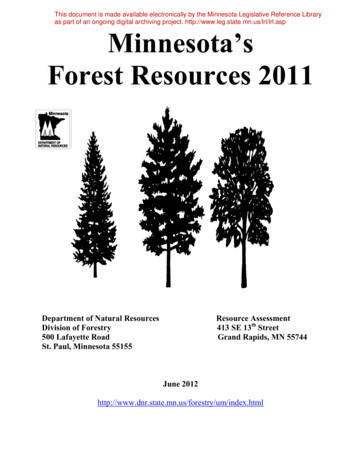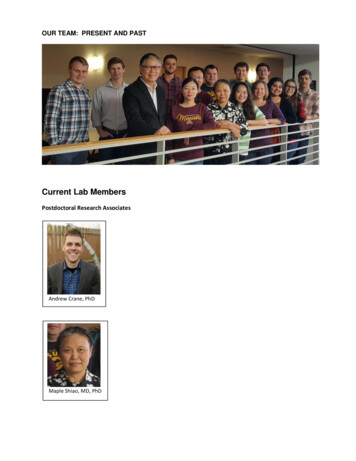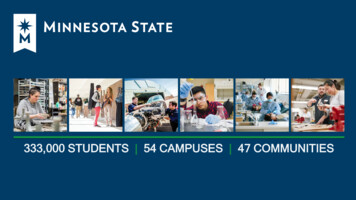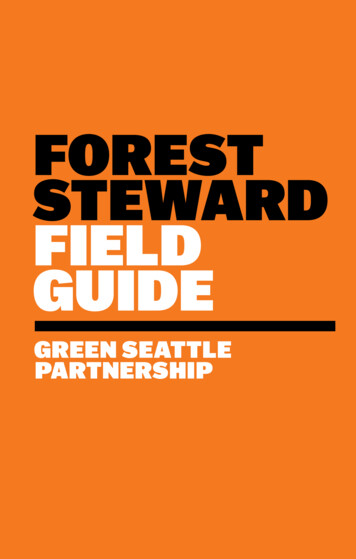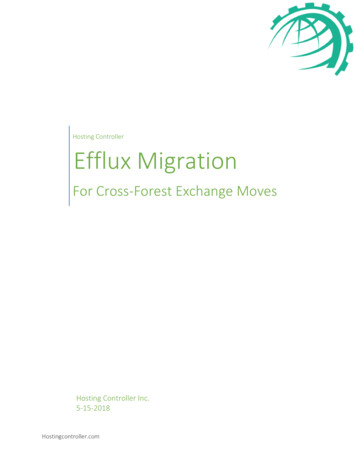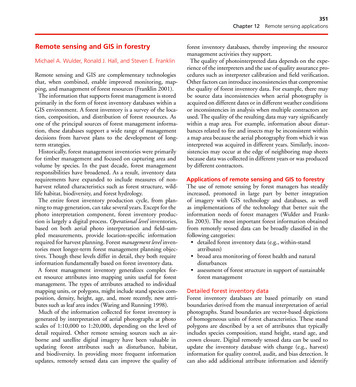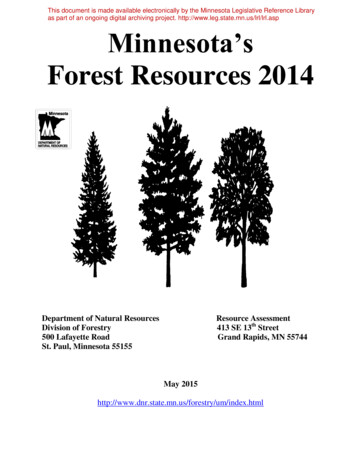
Transcription
This document is made available electronically by the Minnesota Legislative Reference Libraryas part of an ongoing digital archiving project. sForest Resources 2014Department of Natural ResourcesDivision of Forestry500 Lafayette RoadSt. Paul, Minnesota 55155Resource Assessment413 SE 13th StreetGrand Rapids, MN 55744May tml
Minnesota’s Forest ResourcesRevised 05/15PrefaceThis report is compiled annually by Minnesota DNR – Forestry Division, Resource Assessment andUtilization & Marketing Program staff. Publication began in the mid 1980s by John Krantz, formerUtilization & Marketing Program Coordinator and has recently been overseen by Keith Jacobson. Thereport is intended to answer frequently asked questions about Minnesota’s forest resources such as: currentconditions and trends in forest resources, and forest resource industrial use. Foresters, other naturalresource managers, planners, forest industry, and forest policy makers will find items of interest in thesepages.We thank those who cooperated in providing and updating information for this report. They include manyof Minnesota’s wood product companies, Minnesota DNR staff (particularly Jana Albers, Mike Albers, DonDeckard, Anna Dirkswager, and Brian Schwingle), and the USDA Forest Service Forest Inventory andAnalysis (FIA) unit. All FIA summary data was obtained from FIADB version 1.5.1.06.Resource and Industry Highlights: Overall net growth for all species continued to outpace harvest levels. According to 2013 FIA figures,annual net growth of growing stock on timberland was approximately 5.1 million cords, with mortalityof approximately 3.9 million cords. According to Draft 2012 mill and fuelwood survey data, the volume of wood harvested and utilized byindustry and fuelwood users was approximately 2.93 million cords. Hence, the FIA volumes of netgrowth are significantly above the current harvest levels providing a surplus of wood potentiallyavailable for additional harvest.o Pulpwood harvests of 2012 are down by nearly 850,000 cords compared to 2005 levels,resulting in opportunities (and need) for additional utilization and management.o Reduction in harvests since 2005 due to mill closures.o Two additional primary pulpwood consumers closed in 2012.o The private timberlands acreage offers the largest opportunity for increased timber harvest. The strengthening of the economy, including the housing industry, has allowed several of the primarymills and saw mills to make capital investments during 2012-2013 which will provide for improvedefficiencies, expanded product markets and increased production. Current trends (2014) in Minnesota’s pulpwood harvests indicate an increase in pulpwood productionas a result of industry’s changes with species use, incremental growth in production and increases inpulpwood exports to Wisconsin. Total imports of pulpwood are declining slightly.Harvest levels: Total wood harvested and utilized from timberland by industry and fuelwood users inMinnesota was 2.93 million cords in 2012. Based on analysis of mill consumption (actualsurvey figures are not yet available), it appears that 2013 harvest levels are withinthe 2.4 to 2.7 million cord range.Contact Information:Curtis L VanderSchaaf, Forest ModelerResource Assessment, Division of Forestry,Minnesota Dept of Natural Resources483 Peterson Road, Grand Rapids, MN 55744Questions or requests for additional information can be directed to Curtis VanderSchaaf,Email: curtis.vanderschaaf@state.mn.us, Kent Jacobson, Minnesota DNR Timber Sales BusinessConsultant; Email: kent.jacobson@state.mn.us, or Steve Vongroven, Minnesota DNR Forest ProductsUtilization & Marketing Program Coordinator; Email: steve.vongroven@state.mn.us.2
Table of ContentsPrefaceResource and Industry HighlightsContact InformationWood-Using Industry OverviewWood Energy and Woody Biomass UtilizationResidential Fuelwood ConsumptionForest Resources OverviewHarvest LevelsSustainable Harvest LevelsWood Supply and Demand Information for Important Cover Types and SpeciesAspen/Balm of GileadBirchBalsam FirSpruceTamarackNorthern HardwoodsMapleBasswoodOakLowland HardwoodsAshRed PineJack PineWhite PineWhite CedarTimber Price InformationGlossary and Conversion 576164677073
Wood-UsingIndustryOverviewA brief overview of Minnesota’s wood-using industry, including mill location and productinformation for many of the larger mills, and total industry economic impact.4
Minnesota’s Forest Industry at a Glance 1Economic Impact 2013 8.9 billion direct value of shipments with 16.0 billion total output effect. 3.1 billion direct value added with 7.2 billion total value added effect. 5th largest manufacturing sector in Minnesota by employment (#1 food products, #2 computers &electronics, #3 fabricated metal products, and #4 machinery). 30,100 direct jobs with 63,200 jobs total employment effect. 3.2 billion payroll effect with 1.5 billion in direct payroll. 80 million stumpage revenue received by land owners. 24 value added by primary manufacturing per 1 stumpage value. 452 million total state and local tax receipts effect.Important Industrial SectorsPulp, paper, paperboard, converted paper products, window & door components (MN # 2 in U.S.), kitchencabinets and cabinet parts, store fixtures, wood office & residential furniture, pallets & crating, millwork,wood shavings for poultry industry, and woody biomass energy (14 facilities with greater than 10,000 cordsannual consumption).Non-Traditional Industries Dependent on Minnesota’s Forest LandsBalsam boughs for wreath industry with annual sales exceeding 20 million, decorative spruce tops, birchbark, maple and birch syrup, wood for grilling and smoking (e.g. ash, black walnut, birch, hickory, maple,oak), and medicinal plants.1CY 2013 data unless otherwise noted; compiled by Don Deckard, Ph.D., Forest Economist, Minnesota DNR.5
Value Added (Gross State Product) per CapitaIn 2012, Minnesota was ranked seventh nationally in forest products manufacturing with 524 direct valueadded (Gross State Product) per capita.Manufacturing Facilities as of January 2014 4 primary pulp & paper mills and 3 recycled pulp & paper mills 106 converted paper products plants 330 sawmills and wood products plants 361 wood kitchen cabinet and countertop manufacturers 67 wood furniture and millwork shopsVolume of Timber HarvestedAnnual harvest volume 2.93 million cords including: Pulpwood 2.16 million cords (2012) Sawlogs & specialty 247 million board feet (2010) including the following specialty items:- Veneer (2007) 4.5 million board feet domestic plus 0.6 million board feet exported- Shavings (2007) 11,000 cords (animal bedding)- Posts & Poles (2007) 8,000 cords Residential fuelwood 183,000 cords live trees from timberland (2012)6
Minnesota Pulp and Paper – 2014FirmWood UsedUPM - Blandin Paper MillGrand RapidsBoise White Paper, LLCInternational FallsAspen, Balsam Fir, Basswood,SpruceAspen, Balm, Pine, Spruce, BalsamFir, Birch, Tamarack, MapleNewPageDuluthBalsam Fir, Spruce, small amount ofPineSAPPI North AmericaCloquetAspen, Maple, and minor amounts ofbirch and ashProductLightweight coated publicationpapersOffice papers, label and releasepapers, base sheets, business andspecialty printing gradesUncoated, lightweightsupercalendered magazine andpublication papersCoated freesheet fine printing andpublication paper, market pulpSpecialized celluloseRecycling MillsRock-Tenn CompanySt. PaulNewPageRecycled Fiber MillDuluthLiberty Paper CompanyBeckerRecycled paper and corrugatedCardboard and corrugated boxesHigh grade office paper andcomputer paperMarket pulpRecycled paper and corrugatedCardboard and corrugated boxesMinnesota Oriented Strand Board and Engineered Wood Products – 2014FirmLouisiana-PacificTwo HarborsNorbordBemidjiWood UsedProductAspen, Balm, BirchOSB – engineered siding panelAspen, Balm, Birch, MapleOSBMinnesota Hardboard and Specialty – 2014FirmInternational BildriteInternational FallsJarden Home BrandsWood UsedProductAspen, Balm and recycled paperSheathingAspen, BirchSpecialty wood products for foodindustry, matches, otherFor additional information about sawmills, pulp and paper mills, Oriented Strand Board mills, veneer mills,and dry-kiln facilities in Minnesota go to the following website and click on the Minnesota Primary ForestProducts Producer Directory html7
Minnesota Large Sawmills – 2013Mills Exceeding 3,000,000 Board Feet of Annual ProductionEconomic importanceThe sawmill sector is very important to forestry because it creates market diversity. The approximately494,900 cords used annually is about 17% of the statewide timber harvest and provides value-addedmarkets for various species, sizes, and qualities of timber. In addition, sawmills provide products we alluse, as well as providing significant employment and economic benefits for many rural communities.Sawmills can also have a complementary impact on other wood industry sectors. For example, somesawmills send residue chips to paper mills, benefitting both sectors. Also, the higher-value sawlog marketcan help make logging residue economically accessible as woody biomass for energy. Finally, high valuemarkets are also important to landowners through harvest compensations, which helps them afford toengage in other management activities.There are over 500 sawmills in Minnesota, but most are small, portable bandsaw mills that account for atiny fraction of wood use. In contrast, 32 large sawmills in Minnesota utilize more than 1 million board feetannually. In fact, the top 10 mills by production volume account for over 70 percent of the total, with onelarge softwood mill accounting for about 40 percent of the total volume utilized by all sawmills.FirmWood UsedProductCass Forest Products, Cass LakeAspen, Jack Pine, Red Pine, White PineCants, lumberHawkins Sawmill, IsleMixed HardwoodsCants, lumberHedstrom Lumber CoGrand MaraisAspen, Jack Pine, Red Pine, White Pine,White SpruceLumberPallet Lumber Mill MN (formerRemer Cut-Stock) RemerPotlatch CorporationBemidjiMixed HardwoodsPallet lumberBalsam Fir, Jack Pine, Red Pine, WhiteSpruceLumberRajala Mill Co.BigforkBlack Ash, Aspen, Basswood, Paper Birch, HardMaple, Red Oak, White Oak, Red Pine, WhitePine, White Spruce, TamarackBlack Ash, Aspen, Balsam Fir, Basswood, PaperBirch, Jack Pine, Red Pine, Black SpruceCants, lumber, veneerRoot River Hardwoods IncPrestonSavanna PalletsMcGregorBasswood, Elm, Green Ash, Hickory, HardMaple, Red Oak, White Ash, White Oak, WalnutCants, lumber, veneer logsBlack Ash, Aspen, Basswood, Paper Birch,Mixed Hardwoods, Red Oak, PineBoxes or crates, pallets/skids,hardwood lumberWoodline SawmillOnamiaBlack Ash, Aspen, Basswood, Paper Birch,Hard Maple, Soft Maple, Red Oak, PineLumber, pallets/skidsRajala Timber Co.Deer River8Cants, lumber
A comparison of MN sawmill utilization from 2001 to 2007 reveals several key changes. In total, thesawmill consumption declined during this period by 53,463 mbf. The changes were primarily located in thehardwood capacity since the softwood consumption is basically unchanged during this period. Of thechanges in the hardwood capacity, the primary decline in species utilization was in the use of aspen; whichhas declined by 34,800 mbf.MN Sawmill Consumption (MBF)2001Hardwoods149,764Softwoods135,839Misc ,57013,458Total MBF272,273248,401301,86440%55%5%Changes in softwood species consumption during the 2001 to 2007 period include a 42% decline in the useof jack pine and a corresponding 49% increase in the use of red pine. Other softwood species showingchanges during this period include a near doubling in the use of spruce and close to a 50% increase in theuse of balsam fir. The spruce and balsam fir species volumes utilized as sawtimber during this periodincreased from 7% of the 2001 total softwood volume to 13% of the 2007 total softwood volume.9
Location of mills is an important factor in determining markets for wood. The map above shows the OSB,pulp & paper, recycled fiber, hardboard, sheathing and larger sawmills in Minnesota. These mills utilizevarious species of wood material, with aspen pulpwood being by far the largest component.10
Wood Energy and Woody Biomass UtilizationDue to the decreasing demand for paper products, changes in international markets, and the recentcollapse of the housing market, Minnesota continues to experience decreasing demand fortraditional forest products such as Oriented Strand Board (OSB) and pulp and paper. Pressure tofind local, renewable and climate friendly alternatives to petroleum based fuels and chemicals isproviding Minnesota with an opportunity to sustainably use our forest resources for bio-basedmarkets in addition to supporting our traditional forest products industry. In addition to pulp andpaper, trees can be used to make thermal energy, electricity and power, renewable chemicals andas liquid fuels.Woody biomass includes, but is not limited to: logging residue (non-merchantable tops and limbsleft over from a commercial timber harvest along with non-merchantable small-diameter trees andstems, dead standing trees, and down logs), primary and secondary mill residue, dedicated energycrops, urban forest clearing material, land clearing material and brushland material. Within the lastcouple of years, woody biomass utilization has also included whole-tree chips due to a decrease inavailable logging residue resulting from decreased levels of commercial timber harvest.Woody biomass continues to be used as a source of renewable energy for both industrial and nonindustrial applications in Minnesota. As propane prices remain volatile and challenges withpropane supply continues, the demand for woody biomass for thermal applications also increases;especially for commercial and residential facilities not connected to a natural gas line. In the forestproducts industry, using woody biomass for combined heat and power or for thermal applicationsis a practice that has placed a demand on biomass for over thirty years.The prospect of expanded woody biomass harvesting and processing has many potential benefits,including: reduced dependence on foreign energy sources, improved bottom lines for logging andprocessing operations, increased opportunities for forest and wildlife management, and additionalvalue-added product lines for the forest products industry. In fact, increased utilization of woodfor bioenergy can be a tool for offsetting forest and wildlife management costs.Mitigating for potential negative effects associated with biomass harvesting must be done in orderto allow biomass markets to expand in a sustainable and environmentally healthy manner. Severalsafeguards are effectively used in Minnesota including: 1) The Biomass Harvesting Guidelines(http://www.frc.state.mn.us/initiatives sitelevel management.html), 2) third-party ification/index.html), and 3) Minnesota’s Master LoggerProgram (http://mlep.org/).Sources of Woody BiomassSome sources of woody biomass include: Logging residue. Tops, limbs and trees below industry utilization standards leftover fromcommercial timber harvest operations.“Primary” mill residue from sawmills, etc. Excepting a couple of sawmills, the majority ofavailable primary mill residue is utilized for various products; most commonly burned toproduce energy.“Secondary” mill residue from cabinet manufacturers, etc. The majority of the residue isutilized.Dedicated energy crops. A very small resource in Minnesota at present.11
Land clearing projects. This contributes to the metropolitan wood supply for a majorenergy facility.Brush from brushlands. A significant potential resource, but the economics of harvestingand procurement technology need to improve before widespread use.Precommercial thinning, Timber Stand Improvement (TSI), fire hazard reduction, andvegetation management projects. A potential fiber source from intensified forestry andwildlife management.Urban forests. A fiber source from tree clearing and maintenance and storm cleanup inurban areas. Largely used in mulch markets in major metropolitan areas as well as forenergy in St. Paul.Roundwood. Given mill shutdowns and curtailments, a meaningful amount of woodybiomass in the form of roundwood has been used over the past few years.Markets for Woody BiomassWoody biomass markets normally use portions of the forest resource without traditional forestproduct markets such as tops and limbs, small diameter timber, poorly formed trees, under-utilizedspecies, disease or insect infested trees, some forms of wood manufacturing residue, andpotentially brush. Two main factors keep small-diameter timber, tops and limbs and brush frombeing used for most traditional forest products:1) The high percentage of bark relative to wood fiber; bark fiber is not suitable for many products.2) The high cost of processing smaller-diameter material. Processing efficiency is greater whenusing larger material.Woody biomass is a good fit for a number of products and markets including: Engineered wood: The International Bildrite insulite mill in International Falls is anengineered wood product mill in Minnesota that utilizes bark-on chips.Special Forest Products (SFP): Markets include log furniture, craftwood, etc. These tend tobe small volume, but high value markets.Landscape mulch: Markets are limited in rural Minnesota, but are significant nearmetropolitan areas.Animal bedding: Animal bedding markets are limited in some of the highly forestedregions of Minnesota because most of the poultry and dairy industry is located in thecentral and southern portions of the state.Energy: Energy is by far the largest market for woody biomass in Minnesota. The tablebelow contains a list of some of the larger (greater than 100,000 oven dry tons annually)woody-biomass energy facilities in the state.Some Large Wood-Fired Energy Producers in MinnesotaCompany NameCityFuelMinnesota PowerSAPPIMinnesota PowerSt. Paul District EnergyLaurentian Energy AuthorityFibroMinnMinntac Taconite KilnGrand RapidsCloquetDuluthSt. PaulHibbing/VirginiaBensonMountain IronMill residue, logging residue, roundwoodMill residue, logging residue, roundwoodMill residue, logging residue, roundwoodUrban wood waste, roundwood, logging residueLogging residue, mill residue, roundwoodTurkey manure, logging residue, roundwoodMill residueIn addition to the list above, there are many small medium and small wood processing companies that burn some or all of theirwood waste for heat and/or process steam.12
Forestry OpportunitiesSeveral opportunities exist to use woody biomass in a manner consistent with achieving soundnatural resource management goals. Resource managers can use biomass harvesting as a tool toachieve desired conservation goals through the following practices: Harvesting logging residue. In addition to local economic benefits, use of this material can,on some sites, improve ease and success of regeneration and reduce fuel loading and firedanger. Forest health management and invasive species control. Opportunities may include barkbeetle control in small diameter pine thinnings, spruce sanitation harvests to control dwarfmistletoe, and removal of trees infested with Emerald Ash Borer (EAB). Harvesting brush from brushlands. There are potential wildlife habitat benefits frombrushland management. “Precommercial thinning”, Timber Stand Improvement (TSI) and fire hazard reduction. Asource of currently non-economically recoverable woody material is produced during forestmanagement activities such as very early thinnings and wildfire hazard reduction work. Ifthe economics become profitable and ecological concerns are addressed, the potentialbenefits of doing more of this work could be significant.What is the Future for Woody Biomass? Potentially, future policy trends leading toward reduced green house gas emissions andincreased renewable energy development point toward the expansion of woody biomassutilization over the next decade and beyond. Technologies to expand the use of biomass for increased value added products like motorfuels and green chemistry substitutes are edging toward commercial deployment. Using woody biomass more broadly is an emerging issue that requires time to sort outnatural resource management issues and market development. The extent to which woodybiomass is used as a renewable energy resource depends on a multitude of factorsincluding, but not limited to: the price and availability of alternate energy sources,procurement and operation costs of biomass resources, and state and federal renewablepolicies. Woody biomass can play an important role in Minnesota’s energy system by contributingto a wide range of energy markets for which other renewable energy sources are notsuitable. For example, biomass can be used for industrial process heat or to produce liquidfuels where wind and solar energy cannot. The DNR is interested in bioenergy for these main reasons: to mitigate climate change, asa conservation and habitat management tool and as an economic opportunity.13
Residential Fuelwood ConsumptionThe Minnesota Pollution Control Agency (MPCA) periodically conducts a statewide survey to findout how much wood is harvested and burned annually for heat or pleasure in Minnesota. Thissurvey has been conducted in one form or another every few years since 1960. Historically, thesurvey was conducted by the Minnesota Department of Natural Resources (MDNR) and the USForest Service. The survey data has been used by a variety of state and federal agencies as well astrade organizations to manage forests, to inform policy makers and scientists, and to assist thehearth and fireplace industry by examining trends in wood burning.The MPCA conducted this latest survey in 2012 to gather additional information about woodcombustion practices. Due to the levels of fine particles (PM2.5) in ambient air, it is important tohave accurate information about the sources of this pollutant. While wood combustion is not thelargest source of fine particle concentrations in the air, residential wood combustion is animportant source of fine particle emissions. The survey provides an improved understanding of theresidential wood burning in Minnesota, by type of equipment, by purpose for burning, by source ofwood fuel, and by region of the state.The general findings of the survey show that Minnesotans burned approximately 1.3 million cordsof wood between July 1, 2011 and June 30, 2012. This suggests the amount of residential woodburning is on the rise. However, due to changes to improve the survey design and methodology,comparisons across surveys to identify trends should be done with caution.Much of the apparent increase seems to be due to more households burning wood for pleasure,predominantly in outdoor recreational burning equipment. The amount of wood burned perhousehold does not seem to have drastically changed, but what has changed is the number ofhouseholds burning wood, largely due to the increasing popularity of backyard recreationalburning.The forest resources data on timber harvests used in this annual report is focused on the utilizationof live trees harvested from the state’s timberlands; from all ownerships. The residential fuelwoodsurvey collected the total volume of wood burned from all fuel types and sources includingroundwood, slab wood, wood pellets, wax logs, and pallets. The fuelwood survey also collecteddata on harvest sources from live trees from forestlands, dead trees, cut trees and or tops andbranches after a timber harvest, live or dead trees from pasture, croplands, and yards inside citylimits or other non-forest lands.Using the findings from the 2012 MPCA survey report, the total fuelwood consumption of1,286,062 cords can be separated by fuel types and sources to determine the amount of fuelwoodfrom live trees from timberlands.Total residential fuelwood consumption:1,286,062 cordsPercent of roundwood/logs and split wood:94.9 %Percent of wood from live trees from forestland:15.0 %Calculated volume of cords from live trees:183,070 cords14
ForestResourcesOverviewA brief overview of Minnesota’s forest resources, including total forestland and timberland acreage,cover type percentages and an ownership breakdown for timberland.15
Minnesota Acres of Land by Major Land Use2013 FIA Total Acres: Approximately 54,000,000Timberland,15,654,278,29%Non Forest,33,329,256,62%OtherForestland,444,368, 1%ReservedForestland,1,279,699, 2%Source: USDA Forest Service 2013 FIA databaseAccording to 2013 FIA data, Minnesota currently has about 15.7 million acres of forest land that isclassified as “timberland”. Timberland is forest land that is productive enough to produce a commercialcrop of trees and is not reserved from harvesting by policy or law. Reserved forestland is land reservedfrom harvest by policy or law, including designated wilderness areas like the Boundary Waters Canoe Area(BWCA), old growth reserves, and others. Other forestland is mostly forested land of very lowproductivity for tree growth, such that it is incapable of producing a commercial crop of trees.Ownership of timberland is an important factor in assessing many issues, including timber supply. Industryincludes Real Estate Investment Trusts (e.g. Potlatch Corporation), Timberland Investment ManagementOrganizations (e.g. Molpus Woodlands Group), and integrated timber companies such as UPM Blandin andRajala Timber Company.The reduction of nearly 800,000 cords of harvest since 2005 has primarily impacted the non-industrialprivate landowner (e.g. individuals, families, farmers, etc.). This represents a significant marketopportunity for the surplus timber supply potential from the private forest management needs.16
Minnesota Forest Type AcreageAll OwnershipsTotal Timberland Acreage 15.7 MillionBalsam poplar3%Cottonwd Willow0%Aspen30%Non stocked1%Birch5%Other4%Jack pineRed pine2%4%Lowland hdwds9%N hdwds10%Oak9%Tamarack7%Black spruce9%White pine1%Balsam fir2%White spruce1%N white-cedar4%Source: USDA Forest Service 2013 FIA databaseForest Type: A classification of forest land based on the species forming a plurality of live tree stocking.It is worth noting that aspen is by far the largest forest or “cover” type in Minnesota.Area of Timberland in Minnesota by DNR Forest Type – 2013Forest TypeAcresAspenNorthern HardwoodsOakLowland HardwoodsBlack SpruceTamarackBirchRed PineWhite CedarBalm of GileadBalsam FirJack PineWhite PineWhite SpruceCottonwood/ WillowOther SoftwoodsNon-Stocked & OtherTotal All e: USDA Forest Service 2013 FIA Database*Totals may not sum due to rounding.17
Harvest LevelsInformation on 2012 timber harvest in Minnesota by product category and estimation ofcontribution by timberland ownership.18
Total wood harvested and utilized by industry and fuelwood users in Minnesota(in thousand cords - by species – from timberland)(Pulpwood 2012 (DRAFT); Sawtimber 2010 (DRAFT); Fuelwood 2012)SpeciesPulpwood* SawlogsResidentialCommercial Totalwood fuels*&fuelwood**Others*Aspen and Balm1366.164.69.217.81457.7Paper am ite Cedar0.62.91.80.05.3Other 931.3MapleCottonwoodOther HardwoodSub-TotalHardwoodPineRed PineWhite PineJack PineSub-Total SoftwoodOther and mixedspeciesTotal62.32159.3494.9183.0Source: USFS and MN DNR mill surveys & residential fuelwood survey.-Figures in chart may not total exactly due to rounding*Draft**Fuelwood removed from live trees on timberland.-Figures include cords of pulpwood exported to Wisconsin and Canada: Aspen: 79,964; Spruce: 52,184; Red Pine: 20,003(only WI); Jack Pine:19,810; Maple: 13,316 (only WI); Birch: 23,606 (only WI); Ash: 5,281 (only WI); White Pine: 4,547(only WI); Tamarack: 3,634; Basswood: 2,022 (only WI); Red and White Oak: 1,542 (only WI); Balsam Fir: 648; NWC: 42(only WI); Elm: 3 (only WI); and total cords of sawlogs mainly exported to Wisconsin and Iowa of: 31,200, most of which isOak and Maple.Based on analysis of mill consumption (actual survey figures are not yet available), itappears that 2013 harvest levels may decline to 2.5 million cords or below.Pulpwood numbers from 2012 reflect operations by the mills listed on page 7, including Verso Paper in Sartell and GeorgiaPacific Corp in Duluth. In 2012, Verso curtailed operations during May and the GP mill shutdown during August. Therehave been no large-scale sawmill closings since 2010 and no large-scale biomass facility closings since 2008; exceptingVerso Paper.
Total Wood Harvest in Minnesota from Timberland1998 - 20125.0Million Cords4.03.66 3.82 3.72 3.56 3.68 3.60 3.58 3.733.153.02.83 2.96 2.73 2.81 3.02 rce: Pulpwood (USFS, Northern Research Station), sawtimber and fuelwood (MN DNR surveys).Estimated Volume of Timber Sold/Harvested in Minnesota byOwnershipIndustryPrivate Land2.5Million CordsTotal Public Land21.510.5097 98 99 00 01 02 03 04 05 06 07* 08* 09* 10* 11* 12*YearSource: Public Lands: Public Stumpage Price Review through 2006. Beginning with 2007, annual volume scale reports(harvested) are used for State and Federal lands rather than volumes sold. Change necessary due to large volumes of
Minnesota's Forest Resources 2014 Department of Natural Resources Resource Assessment Division of Forestry 413 SE 13th Street 500 Lafayette Road Grand Rapids, MN 55744

